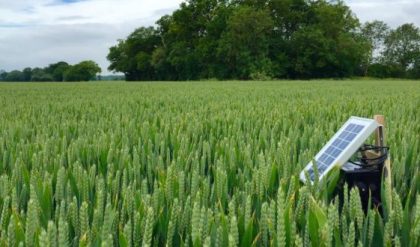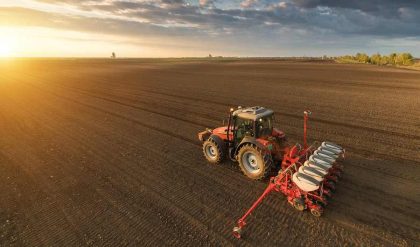Several devices are commonly used for measuring irrigation water. They grouped into four categories
1) Volumetric Measures
2) Velocity-Area Methods
a) Float Method
b) Water Meters
3) Measuring Structures
a) Orifices
b) Weirs
c) Flumes
4) Tracer Methods
Volumetric methods (Using a container)
A simple method of measuring a small irrigation stream is to collect the flow in container of known volume for a measured period. An ordinary bucket or barrel is used as container. The time required to fill the container is recorded with a stopwatch or with seconds on wristwatch. The rate of flow is measured as below
Volume of container (liters)
Discharge rate liter/second = ———————————–
Time required to fill (seconds)
PROBLEM: A 24 liter capacity bucket is filled in 10 seconds by discharge from a Persian wheel. What is rate of flow?
24
Solution: Discharge ratio liter/second = —–
10
= 2.4 liter/second or 144 liter/minute
2) Velocity area method:
a) Float method:
The float method of making of rough estimates of the flow in a channel consists of nothing the rate of movement of a floating body. A long necked bottle partly filled with water or black wood, an orange or lemon may be used as float. A straight section of the channel about 30 meters long with uniform cross section is selected. Several methods of depth and width are made within the trial section to arrive at average cross sectional area. A string is stretched across each end of section at right to the direction of flow. The float is placed in the channel a short distance up stream from the trial section. The float needed to pass from upper end to lower end of the section is recorded. Several trials are made to get average time of travel. To- determine the velocity of water at the surface of the channel, the length of the trial section is divided by the average time taken by the float to cross it. Since the Velocity of the float on the surface of the water will be greater than the average velocity of the stream; it is constant factor, which is usually assumed to be 0.85. To obtain the rate of flow , this average velocity ( measured velocity x co-efficient) is multiplied by the average cross sectional area of the stream.
Discharge or rate of flow = area x velocity
Q = A X V where Q= discharge rate in m3/sec. v = velocity of flow in m/s
a = cross section al area of channel in m2
b) Water meters:
Water meters utilize a multi blade propeller made of metal, plastic or rubber, rotating in a vertical or horizontal plane and geared to a tataliser in such a way that a numerical counter can totalize the flow in any desired volumetric units, water meters are available for a range of sizes suiting the pipe size commonly used on the farm. There are basic requirements for accurate operation of the water meter.
(1) The pipe must flow full at all times.
(2) The rate of flow must exceed the minimum for the rated range.
Meters are calibrated in the factory and field adjustments are usually not required. When water meters are installed in open channels, the flow must be brought through the pipes of known cross sectional area. Care must be taken that no debris or other foreign materials obstruct the propeller.
3) Water measuring devices:
a) Orifices:
Orifices in open channel are usually circular or rectangular openings in vertical bulk head through which water flows. The edges of opening are sharp and often constructed of metal. The cross sectional area of orifice is small in relation to the stream cross section. Orifice may operate under free flow or submerged flow conditions. The types of orifices are
I) Orifices below the level of inlet: The discharge through a closer orifice in which the orifice is situated below the level of inlet is calculated by the equation.
Q = Ca x under root (2gh)
Where, Q = Quality of flow in C. ft/Sec.
a+ Cross sectional area of water, the canal or orifice in sq. ft.
c = A constant which varies from 0.6 to 0.8 or more depending upon the position of orifice relative to the sides and bottom of vessels or the degree of roundness of the edge of orifice.
g= Acceleration due to gravity. (32 feet / sec/sec)
h= Height of water level in cistern from the middle of the orifice in feet.
II) Discharge through an orifice situated at higher level than inflow pipe: When the orifice is situated at a higher level than the inflow pipe, the discharge is calculated according to the equation.
Q = CLh1.5
Where D= Length of orifice in feet and
C= 2C 2g
H= head of water.
III) Discharge through submerged orifice:The discharge through a submerged orifice is given by the equation.
Q=0.61 LH 2gh
E.g. if L=1.0 H=0.5ft. h=0.25 ft. and g=Acceleration due to gravity (32ft/sec/sec) then Q=1.22 C, ft/sec.
b) Discharge through Weirs:
A wear means a notch in a well built across a stream. The notch may be (a) rectangular (b) Trapezoidal and (c) 90 degree V (Triangular) notch or weir.
(a) Rectangular notch or weir: The length of a weir may be equal to width of the upstream channel or less than it. The discharge through a rectangular weir, in case of complete end, contraction is given by the equation.
Q = 3.33 (L-0.2 H) H^1.5
Where L= measured length of the weir
L= effective length of weir in feet.
L= L-0.2H)
(b) Trapezoidal or Cipolletti Weir:
The discharge of water is given by the equation
Q= 3.367 LH ^ 1.5
L1 + L2
Where = ————–
2
(c) Discharge through 90oV notch:
The discharge is given by the equation:
Q= 2.49 H ^ 2.48 = 2.5H^2.5
c) Parshall flume or (Venturi flume):
Parshall (1950) has decided a device in which the discharge is obtained by measuring the loss in the head caused by forcing a stream of water through a throat or converged section of a flume with a depressed bottom. The loss in head is very small in this device. The accuracy of measurement in the Parshall flume is within allowable limits of 5% the flumes ranging from 3 inches to 10 feet throat width are used, which gives the range of discharge of 1/30 to 200 ousecs. The flumes of 3, 6 and 9 inch size are generally used in field measurement.
The ration between the reading at Hb and Ha point should be carefully studied. This ratio should not exceed 0/3 for 3 inch, 6 inch 9 sized Parshall flumes otherwise correction needs to be applied. When the ratio is less than 0.6, it is termed as free flow and exceeds 0.6, it is called submerged flow.
CUT THROAT FLUMES: Skogerboe eqal. (1967) have developed cutthroat flumes for measurement of water. Since there is no throat section (Zero throat flumes), the flumes have been given the name as out throat flumes by the designers. The flumes have a level floor as apposed to the inclined floor in the throat and exit section in the partial flumes. it is placed in a concrete lined channel or on a channel bed conveniently. Every flume has the same all lengths in both the entrance and exit sections. These flumes consist of converging inlet section and diverging outlet section, under free flow conditions. The discharge Q through a cutthroat flume depends upon the upstream depth of flow Ha. The basic form of the free flow equation is-
Q=CH a 1.56
Where C=3.50 W 1.025 (W=throat d width infect)
4) Tracer Methods:
These methods are independent of stream cross section and are suitable for field measurements with out installing fixed structures. In these methods, a substance (tracer) is concentration form is introduced into flowing water and allowed to thoroughly mix. The concentration of the tracer is measured at down stream section. Since only the quantity of water is necessary to accomplish the dilution is involved, there is no need to measure velocity, depth, and head, cross sectional or any other hydraulic factor usually considered in discharge measurement. The relationship between size of stream, time of application, area to be irrigated and depth of water to applied is as below.
Qt=ad
Where Q=Size of stream or discharge (liter/second) or (ha. cm per hour)
t=the time of application of water (seconds or hour)
a=area (sq. m or hectare)
d=Depth in cm that the volume of water used would cover the land irrigated, if quickly spread uniformly over its surface.




